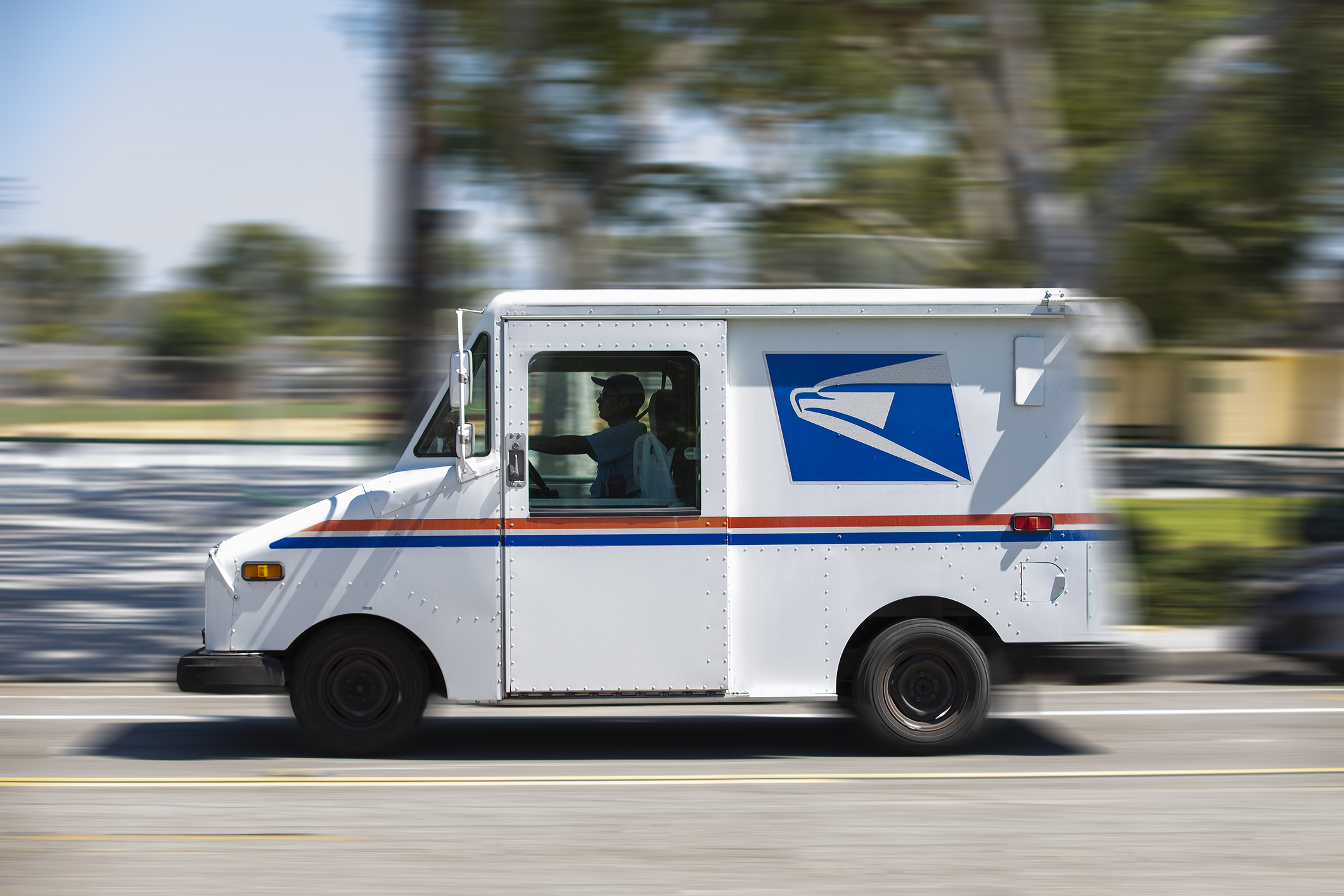The US Postal Service Does More Than Deliver Mail
With talk of cuts to the USPS swirling, here are six ways it provides vital services to the nation’s older adults.


Change is afoot at the United States Postal Service with Postmaster General Louis DeJoy announcing Monday he is stepping down.
His resignation comes as talk of privatization and job cuts under the Trump Administration are swirling for the 250-year old independent service.
In a statement DeJoy said: “we have instituted enormous beneficial change to what had been an adrift and moribund organization” but that “much work remains that is necessary to sustain our positive trajectory.” Deputy Postmaster General Doug Tulino will be in charge until the USPS Board of Governors names a permanent successor.
From just $107.88 $24.99 for Kiplinger Personal Finance
Become a smarter, better informed investor. Subscribe from just $107.88 $24.99, plus get up to 4 Special Issues

Sign up for Kiplinger’s Free Newsletters
Profit and prosper with the best of expert advice on investing, taxes, retirement, personal finance and more - straight to your e-mail.
Profit and prosper with the best of expert advice - straight to your e-mail.
Earlier this month DeJoy agreed to let the Elon Musk-led Department of Government Efficiency or DOGE into the USPS. In a letter to congress highlighting the work that has been done to the USPS, DeJoy said he was happy to have DOGE assist the agency in finding “further efficiencies."
Since fiscal year 2021, the USPS has reduced its workforce by 30,000 and plans to cut an additional 10,000 workers in the coming weeks under a Voluntary Early Retirement program.
At the same time, Trump has floated the idea of folding USPS into the Department of Commerce and signaled support for privatizing the postal service. Bringing it under the purview of the White House could run afoul of the Postal Reorganization Act of 1970 and would need the approval of Congress.
Six things the Postal Service does beyond mail
While the moves are aimed at improving the finances of a government agency that millions of Americans rely on, any cuts in service could impact older adults, particularly ones in rural areas.
After all, in addition to delivering the mail in snow, rain and heat, the USPS provides vital services that many older adults rely on including these six:
1. Carrier Alert Program: This free service was developed for older adults and people who have difficulty reaching vital services because of an illness or accident.
With this program, you register with your local post office and your letter carrier places a Carrier Alert symbol on your mailbox. That alerts all letter carriers to keep an eye on your mail for any signs of distress such as an accumulation of mail in your mailbox.
When you register for the program, you also register with a local social agency, such as the United Way, American Red Cross, or the local Area Agency on Aging (AAA).
If there are signs of distress, the letter carrier will alert the agency you registered with and that social service agency will try to contact you by phone and via friends and family members. If they can’t be reached, the agency will send someone to your home to check on your wellbeing.
2. Hardship delivery: If you have a hardship that makes it impossible to access your mailbox the USPS will hand deliver it to your door. The post office defines a hardship or medical problem as an illness or handicap which would present a physical challenge for an individual to retrieve mail. To get this free service fill out PS Form 1528.
3. Enable you to buy stamps and more from your letter carrier: This service is particularly helpful for people living in rural areas who can’t easily get to the post office to purchase stamps and money orders. Known as the “Post Office on Wheels” you can:
-Buy stamps.
-Use Express Mail® and Priority Mail® service.
-Mail packages (with or without insurance).
-Use Certified Mail™ or Registered Mail™ service.
-Buy money orders.
4. Fight fraud and crime: With mail theft and fraud on the rise, the USPS has been taking steps to harden physical targets by deploying high security blue collection boxes across the country and reducing change of address fraud by implementing dual authentication identity verification for online changes of addresses.
5. Neighborhood watch: While letter carriers aren’t officially part of a neighborhood watch program, postal workers are in a unique position to spot unusual activity and problems. They can report abandoned vehicles, broken windows and suspicious activity.
6. Raise money for charities: From breast cancer to Alzheimer's research, the postal service sells semipostal stamps, which are first-class stamps that cost more than regular postage, with the proceeds going to charities.
It has raised $98 million for breast cancer research, $8 million for vanishing species, $1.6 million for Alzheimer’s research and more than $2 million for PTSD, among other causes.
Related content
Profit and prosper with the best of Kiplinger's advice on investing, taxes, retirement, personal finance and much more. Delivered daily. Enter your email in the box and click Sign Me Up.

Donna Fuscaldo is the retirement writer at Kiplinger.com. A writer and editor focused on retirement savings, planning, travel and lifestyle, Donna brings over two decades of experience working with publications including AARP, The Wall Street Journal, Forbes, Investopedia and HerMoney.
-
 'Humbug!' Say Consumers, Despite Hot GDP: Stock Market Today
'Humbug!' Say Consumers, Despite Hot GDP: Stock Market Today"The stock market is not the economy," they say, but both things are up. Yet one survey says people are still feeling down in the middle of this complex season.
-
 The SEC Is Concerned for Older Investors and Retirement Savers. Here's What You Should Know
The SEC Is Concerned for Older Investors and Retirement Savers. Here's What You Should KnowThe SEC focusing on older investors, retirement and college savers, and private securities. Here's how those changes impact you.
-
 Vesting, Catch-Ups and Roths: The 401(k) Knowledge Quiz
Vesting, Catch-Ups and Roths: The 401(k) Knowledge QuizQuiz Test your understanding of key 401(k) concepts with our quick quiz.
-
 Vesting, Catch-Ups and Roths: The 401(k) Knowledge Quiz
Vesting, Catch-Ups and Roths: The 401(k) Knowledge QuizQuiz Test your understanding of key 401(k) concepts with our quick quiz.
-
 The 2026 Retirement Catch-Up Curveball: What High Earners Over 50 Need to Know Now
The 2026 Retirement Catch-Up Curveball: What High Earners Over 50 Need to Know NowUnlock the secrets of the 2026 retirement catch-up provisions: A must-read for high earners aged 50 and above.
-
 A 5-Step Plan for Parents of Children With Special Needs, From a Financial Planner
A 5-Step Plan for Parents of Children With Special Needs, From a Financial PlannerGuidance to help ensure your child's needs are supported now and in the future – while protecting your own financial well-being.
-
 I'm 59 With $1.7 Million Saved and Just Lost My Job. Should I Retire at 59½, or Find New Work?
I'm 59 With $1.7 Million Saved and Just Lost My Job. Should I Retire at 59½, or Find New Work?We asked professional wealth planners for advice.
-
 A Wealth Adviser Explains: 4 Times I'd Give the Green Light for a Roth Conversion (and 4 Times I'd Say It's a No-Go)
A Wealth Adviser Explains: 4 Times I'd Give the Green Light for a Roth Conversion (and 4 Times I'd Say It's a No-Go)Roth conversions should never be done on a whim — they're a product of careful timing and long-term tax considerations. So how can you tell whether to go ahead?
-
 A 4-Step Anxiety-Reducing Retirement Road Map, From a Financial Adviser
A 4-Step Anxiety-Reducing Retirement Road Map, From a Financial AdviserThis helpful process covers everything from assessing your current finances and risks to implementing and managing your personalized retirement income plan.
-
 I Drive and Collect Classic Cars: Here’s How I Got in the Game Without Spending a Fortune
I Drive and Collect Classic Cars: Here’s How I Got in the Game Without Spending a FortuneAre classic cars a hobby or an investment strategy — or both? Either way, the vintage car scene is much cooler and more affordable than you think.
-
 The $183,000 RMD Shock: Why Roth Conversions in Your 70s Can Be Risky
The $183,000 RMD Shock: Why Roth Conversions in Your 70s Can Be RiskyConverting retirement funds to a Roth is a smart strategy for many, but the older you are, the less time you have to recover the tax bite from the conversion.